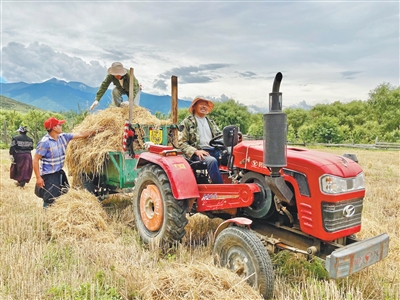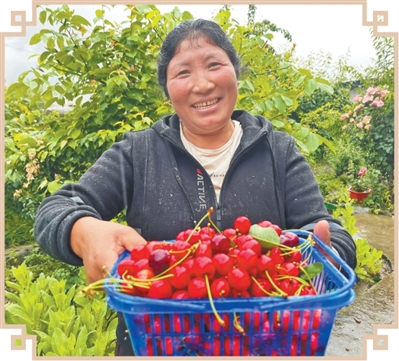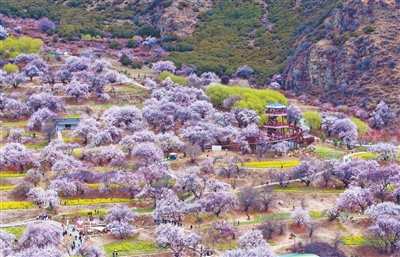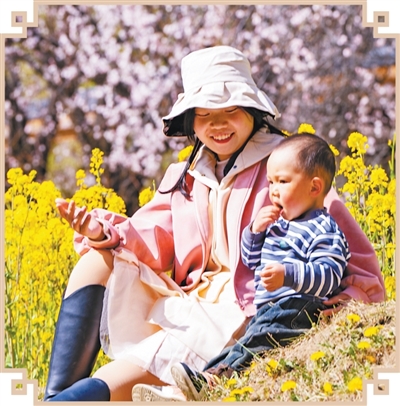




- BRNN
- BRI News
- BRNN News
- Database
Official Documents Polices and Regulations
Inter-government Documents International Cooperation BRI Countries
Business Guide Economic Data BRI Data
Trade
Investment Projects Latest projects
Cases - Content Pool

Villagers gather wheat straw in Kala village, Nyingchi town, Bayi district of Nyingchi city, southwest China's Xizang Autonomous Region. (Photo/Huang Haifen)
Kala village in Nyingchi town, Bayi district of Nyingchi city, southwest China's Xizang Autonomous Region, is known for its peach blossoms. In recent years, the village has made notable progress in developing rural tourism, boosting the collective economy, and promoting ethnic unity.
Villager Dawa Gyaltsen earns most of his income as a driver. In 2003, he bought his first dump truck for 60,000 yuan (about $8,376.84) and began hauling sand and gravel for a local quarry—earning just 10 yuan for short trips and 20 yuan for longer ones. As infrastructure projects in Nyingchi expanded, his transport business took off. Today, he earns over 100,000 yuan a year from transport work.
His income sources have also become more diverse. Last year, a collectively funded orchard began producing fruit. Over 70 mu (about 4.67 hectares) of land now hosts more than 6,000 cherry, pear, peach, and apple trees.

A villager shows freshly picked cherries in Kala village, Nyingchi town, Bayi district of Nyingchi city, southwest China's Xizang Autonomous Region. (Photo/Huang Haifen)
The orchard project took advantage of the village's location near the city. Three years ago, after discussion by the village Party branch, Kala village decided to develop leisure tourism. As a Party member, Dawa Gyaltsen took the lead in planting and managing the fruit trees. "As life improves, people are looking for more leisure activities—so the orchard has real market potential," he said.
Dawa Gyalsten isn't the only villager with a story of improving fortunes.
Years ago, Palbar, Party chief of the village, never imagined that wild peach trees would become a gold mine.
Today, Kala village is known as the "Peach Blossom Village." Every spring, its hills are blanketed in pink blossoms, while roadside stalls beckon with local snacks and creative cultural products.
"In the past, villagers operated food stalls and tourism services individually—disorganized and often harmful to the environment. Now, all tourism projects are run by the village collective," Palbar said.
From January to March each year, Palbar leads the villagers in preparing the orchard—pulling weeds, trimming branches, and clearing debris. "It's like tidying your own home—everyone wants the peach trees to thrive," he added.

Photo shows a peach blossom scenic area in Nyingchi town, Bayi district of Nyingchi city, southwest China's Xizang Autonomous Region. (People's Daily/Xu Yuyao)
During this year's Peach Blossom Tourism and Cultural Festival in April, Kala village welcomed over 110,000 tourist visits and earned 3.6 million yuan in tourism revenue.
More than 30 years ago, tourists visiting the village would trample fields and clamber over fences, angering the locals.
"These trees are useless—they're just a nuisance. We might as well cut them down!" some complained. But Palbar and other village leaders believed these trees are nature's gift and must be protected. The villagers then cleared a section of the orchard to welcome visitors.
In 1995, Kala village opened its first flower-viewing area, charging 5 yuan per person and earning 2,000 to 3,000 yuan that season. The following year, they enlarged the grounds and added restrooms. By the next spring, they'd built a stage and begun hosting performances. Each new addition boosted revenue, and over time, the spring blossom festival became a village tradition.
While protecting the environment, Kala village has enhanced visitor services by constructing skywalks and trails, and linking scenic and cultural sites.
Villagers have also capitalized on the growing tourism industry by opening supporting businesses of their own.
In March 2021, Tseyang, a local villager, converted 10 rooms in her home into the first B&B in the village.

A tourist enjoys a day out with her child in Nyingchi town, Bayi district of Nyingchi city, southwest China's Xizang Autonomous Region. (People's Daily/Xu Yuyao)
In 2020, the Culture and Tourism Bureau of Bayi district, Nyingchi launched a boutique B&B program, and Tseyang's B&B was selected.
"After the renovations, our facilities improved and more guests arrived," she said. Each room now has a private bathroom, reliable internet, and 24/7 hot and cold water. "We planted fruit trees in the yard, which provide blossoms in spring, shade in summer, and fruits in autumn, making my courtyard a highlight in itself," she added with a smile.
Like Tseyang, many villagers have benefited from the improved infrastructure and the rise of tourism. In recent years, Kala village has focused on developing the courtyard economy, encouraging residents to make the most of their traditional homes. All 33 households in the village now grow fruit trees, and 13 run successful B&Bs.
Thanks to its booming tourism and fruit-picking industries, Kala village now earns over 14 million yuan in collective annual income.

Tel:86-10-65363107, 86-10-65368220, 86-10-65363106